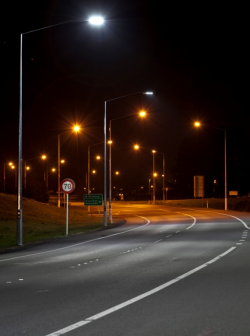One way Waka Kotahi is being more resource efficient is by switching to LED (light-emitting diode) road lighting technology, which is more efficient than other lighting technology. We are encouraging other road controlling authorities (RCAs) to make the switch too.

Transition from LED to HPS (Photo courtesy of ADLTNZ)
We’ve been slowly transitioning to LED road lighting from high-pressure sodium (HPS) lighting and other sources over the last 10 years.
The benefits of LED lights include:
LED road lighting is proving to be the lowest whole-of-life cost lighting option in almost all situations – including for new lighting and the renewal of existing installations. A present-value calculation for the Tauranga Eastern Link estimates a payback period for LED lights of approximately 11 years. As a result, LED lights are the preferred technology for new installations on Waka Kotahi land transport infrastructure projects.
The LED lights we most often use are 4000K* (a neutral white light), as current research into light and road safety indicates this is the best and safest colour temperature for object recognition for drivers and pedestrians. LED lighting is generally referenced in terms of colour temperature, expressed in degrees Kelvin (K).
The specifications for road lighting in New Zealand are outlined in the M30 Specification and guidelines for road lighting design.
M30 Specification and guidelines for road lighting design.
Waka Kotahi therefore expects LEDs will be an included option in all future road lighting investment proposals. In our economic evaluation terms, LEDs generally prove to be the ‘do-minimum’ option in most circumstances.
We’re still learning about any potential risks LEDs may bring. Some articles published internationally have resulted in a number of misconceptions about blue light in relation to road lighting. Blue light is often spoken about in terms of exposure from sources such mobile phones, computers and television.
There is currently very limited evidence to demonstrate a significant health risk for road lighting from LED sources in relation to road lighting. A 2016 study by Public Health England has indicated reaching unsafe exposure limits for blue light risk would require someone to stare into a streetlight for 2.5 hours from a distance of two metres. Therefore, road users and pedestrians are unlikely to reach such exposure limits from LED streetlights.
There has also been some concern about increased light pollution – which is commonly referred to as ‘sky glow’ - in towns around New Zealand because of the switch to LED lighting.
The transition to well-designed LED road lighting –installed to Waka Kotahi specifications – will reduce our contribution to sky glow, as only luminaires with an upward waste light ratio (UWLR) below 1 percent of the total light output are used. This means that the new technology will limit the amount of upward waste light we produce overall. Our target for design of less than 1 percent waste light is significantly less than the current Australian/New Zealand standard of up to 3 percent.
Waka Kotahi’s goals align with the direction of many other organisations in regard to limiting light pollution, however these are not our core goal. The key reason we light our roads is for the safety of our everyone using the transport network.
Dunedin City Council undertook a two-year programme to install 15,000 LED lights from July 2019.
The entire programme of work was expected to take approximately 18 months, with the final installation due to be complete in December 2020. It covered inner-city streets and outer suburbs, as well as state highways.
The council undertook a single-stage business case process to help qualify for NLTF funding, following the standard process. The LED lights were funded through the funding assistance rate (FAR) of up to 85 percent, as Waka Kotahi wanted to encourage all councils to take up the new technology due to the benefits LEDs offer.
In the case of Dunedin City Council, a major incentive was the energy and maintenance savings.
It was also timely, according to Dunedin City Council asset and commercial manager transport Merrin McCrory, as the current lights were due for replacement and the bulbs that had been used in the past were no longer being manufactured.
The council undertook an initial public engagement and, although there was some scepticism from dark skies advocates, Merrin said the council was working to mitigate potential issues as necessary through pro-active community engagement and comprehensive data collation of lighting impacts.
The council undertook a trial period involving three different options of ligh, each installed for a month. The lights were 3000K – or a warm white light. The council then took feedback from the trial to analyse and potentially incorporate into the programme moving forward.
Close